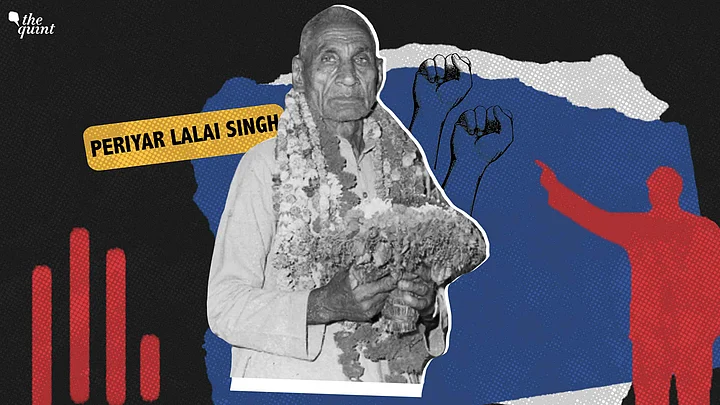After seven years of tireless research, which involved travelling across the country looking for Periyar Lalai Singh's published, unpublished, and out-of-print works, letters, diary entries and so on, Bahujan scholar from Uttar Pradesh, Dharmveer Yadav 'Gagan,' has recently published a five-volume set of Singh's writings.
Gagan, who has a PhD in Hindi literature from Delhi University, hopes that this set, which runs into 2,000 pages, will make an important intervention in understanding the North Indian anti-caste movement in the second half of the 20th century.
Periyar Lalai Singh had made it his life's mission to spread the message of Ambedkarism, Periyarism and Buddhism among the subaltern masses.
Even though he was always on the move, organising camps for the cadre and programmes for the masses in various parts of the country, his base was in a small town of Uttar Pradesh, Jhinjhak, near Kanpur. "He was a true organic intellectual in the Gramscian sense," Gagan tells The Quint.
A Buddhist Doesn't Have a Caste
Periyar Lalai Singh was born on 1 September 1911 in a Yadav family. His father, Choudhari Gajju Singh, was an Arya Samajist.
Singh studied till 7th standard and took up a job as a forest guard in 1929. He later joined Gwalior National Army as a constable.
After he retired from service in 1950, he devoted himself to anti-caste activism. He met Dr BR Ambedkar in 1951 for the first time and was highly impressed by him. Gagan mentions in the first volume that after this meeting, Lalai Singh decided to work towards spreading Ambedkar's thoughts for the rest of his life.
Singh wanted to attend Ambedkar's historic conversion to Buddhism on 14 October 1956 in Nagpur, Maharashtra but had to cancel his trip due to sudden sickness. While, for the next decade, he had already started living by Buddhist principles and was writing about Buddhism, he officially took dhamma deeksha on 21 July 1967 from Mahasthavir Chandramani – the same monk who had given deeksha to Ambedkar.
"At that time he said that the real Buddhist is the one who doesn’t have a caste and got rid of titles such as Kunwar, Choudhari, Yadav from his name and started writing only Lalai Singh as his name," informed Gagan.
Lalai Singh was a materialist. He held the principles of fraternity, compassion and equality in the highest regard and completely stayed away from pujas, rituals, and superstitions. He used to say that the one who wanders around villages and towns spreading the message of Buddha is the true Buddhist.
Periyar of the North
Lalai Singh was deeply influenced by Tamil social reformer Periyar EV Ramasamy. He was the first one to translate Periyar's book Ramayana: A True Reading in Hindi in 1968 under the title 'Sachchi Ramayan'. The book was originally written in Tamil by Periyar in 1930 under the title Iramayanappatirankal and the first English translation appeared in 1959.
The Hindi translation by Lalai Singh led to a huge controversy and the Uttar Pradesh government banned the English as well as Hindi translation and confiscated all the copies. In 1971, the Allahabad High Court, giving the order in Lalai Singh's favour, asked the state government to lift ban, return all the confiscated copies and pay Singh Rs 300.
According to Gagan, Bhikkhu Nirgunnand gave Lalai Singh the title of 'Periyar of the North' in 1968, after which he started to write his name as Periyar Lalai Singh.
One of the Stalwarts of North India
Periyar Lalai Singh was a key leader of Arjak Sangh, a rationalist anti-caste organisation founded by Ramswaroop Verma.
"Chandrika Prasad 'Jigyasu,' Periyar Lalai Singh, Ramswroop Verma, Maharaj Singh Bharti, Jagdev Prasad — these were the icons who, from 1950s to 1975, brought Dr Ambedkar, Jotirao Phule, Buddha, and Periyar to North India," says Gagan.
In his opinion, these leaders had laid the groundwork on which Kanshi Ram built his movement and gained electoral success.
"Much before Kanshi Ram, Chandrika Prasad Jigyasu had introduced the word Bahujan to North India by starting his publishing house, Bahujan Kalyan Prakashan," he adds.
"If you look at the geographical map, Maharaj Singh Bharti came from Merath, Chandrika Prasad Jigyasu from Lucknow while Kanpur gave North India three big thinkers – Swami Achhootanand, Periyar Lalai Singh and Ramswaroop Verma. Babu Jagdev Prasad was from Bihar."Dharmveer Yadav 'Gagan'
Gagan disagrees that North India lacked a robust anti-caste movement in the 20th century.
An Indefatigable Activist
Periyar Lalai Singh was a prolific writer, however, he wrote everything with the aim of raising anti-caste consciousness among the masses. He was one of the first ones to publish Ambedkar's speeches in Hindi.
He ran printing presses under the names such as Ashok Press, Sasta Press and Periyar Press. He had found a publishing house in 1960 under the name Ashok Pustakalay, which he ran till his death. Towards the end of his life, he had also founded the nonprofit, Periyar Charitable Trust.
If one goes through the indexes of the five volumes compiled by Dharmveer Yadav Gagan, one notices that Buddhism, along with other anti-caste issues, remained the key theme of Singh's textual output.
Periyar Lalai Singh died on 7 February 1993. He was really happy when the VP Singh government announced 27% reservation in jobs for the Other Backward Classes in August 1990 as per the recommendations of the Mandal Commission.
Gagan hopes that since the collected works will provide primary material to researchers working on anti-caste movement in North India, it will lead to new insights, especially in the English academia, which has tended to ignore figures like Periyar Lalai Singh. Gagan himself wants to write a cultural history of North India from a subaltern point of view as in the process of collecting Singh's works, he found many works of Chandrika Prasad Jigyasu, Ramswroop Verma, Maharaj Singh Bharti, and Jagdev Prasad too.
